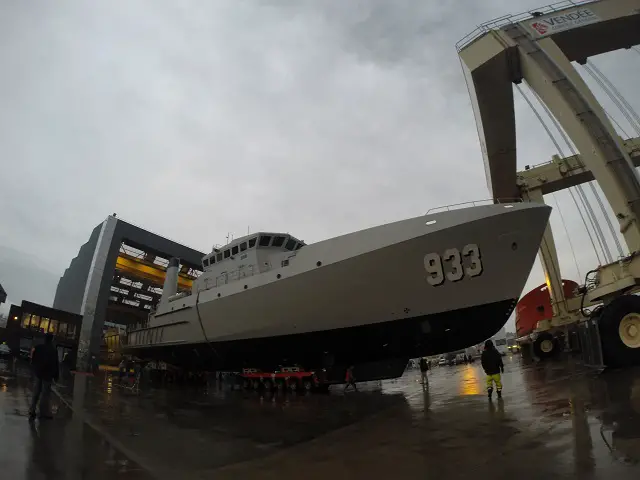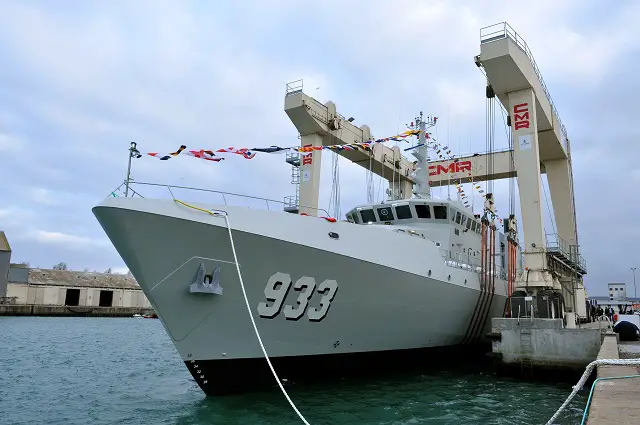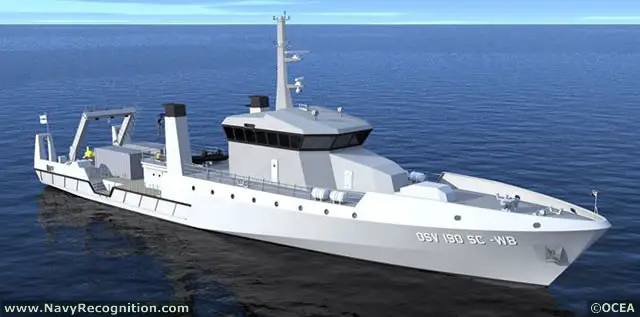In December 2014, OCEA, based in Les Sables d'Olonne on the Western coast of France, launched the first of two "OSV 190 SC-WB" Offshore Survey Vessels ordered by Indonesia for the navy (TNI-AL). OCEA won the contract among 9 bidders (3 from South Korea, 1 from Germany, 4 from France including OCEA and 1 from the Netherlands) following an international tender launched in 2011.  The first of two OSV 190 SC-WB built by OCEA for the Indonesian Navy (TNI-AL). Picture: OCEA ♔
The first of two OSV 190 SC-WB built by OCEA for the Indonesian Navy (TNI-AL). Picture: OCEA ♔
After analyzing the responses offered by each candidates, the Indonesian Ministry of Defense down-selected 3 companies to participate in the final negotiations: 2 from South Korea and OCEA, the only candidate to offer an aluminum vessel.
OCEA was selected as the winner of the tender and signed a contract with the Indonesian Navy on 1 August 2012. The contract includes the delivery of two vessels fully fitted for oceanographic and hydrographic research missions as well as associated logistical support.
The OCEA offer includes a funding agreement with France. Agreement between the banks and the French Ministry of Finance resulted in the keel laying of the first vessel in October 2013. The sister-ship will be launched in Q2 2015. The first of two OSV 190 SC-WB built by OCEA for the Indonesian Navy (TNI-AL) is launched in the water in France last month. Picture: OCEA ♔
The first of two OSV 190 SC-WB built by OCEA for the Indonesian Navy (TNI-AL) is launched in the water in France last month. Picture: OCEA ♔
These ships are designed to study the waters and sea-bottom of the Indonesian archipelago and are therefore equipped with the most advanced technical and scientific equipment:
♔ An AUV (autonomous underwater vehicle by Kongsberg) capable of performing missions autonomously.
♔ An ROV (remotely operated underwater robot by ECA) which is involved in specific tasks.
♔ An 8 meter hydrographic craft equipped for data gathering along the coast in shallow areas. Designed by OCEA the two craft (one for each vessel) will be made in Indonesia.
♔ Several integrated sensors (fitted below the keel at the bow) allow data recovering and analysis.
Integrated logistics support associated with the contract consist in:
♔ Technical Documentation for operation and maintenance.
♔ Crew Training: Technical and Scientific (40 sailors per ship).
♔ Maintenance training (16 people per ship).
♔ On site technical assistance.
OCEA's offer also included a specific formation: A Master's degree in hydrographic science for an Indonesian engineer at ENSTA in Brest (Engineering school specialized in science and technology of the sea).
For the realization of this contract, OCEA works in partnership with the French Navy to optimize the positioning and the selection of scientific equipment and also to assist in the scientific training of crews and technical assistance to Indonesia.
These two ships are the first of an ambitious global project undertaken by the Indonesian Navy, which aims to develop its oceanographic and hydrographic fleet; OCEA's goal is to become Indonesian Navy's partner in the long term. In a country of more than 17 000 islands, the need is obviously very important as was shown during the recent operation for the crashed Air Asia passenger plane. The desire to develop maritime activity in the country has also been confirmed by the new President Jokowi. Artist impression of TNI-AL's future OSV 190 vessel. Picture: OCEA ♔
Artist impression of TNI-AL's future OSV 190 vessel. Picture: OCEA ♔
OSV 190 SC-WB Mission:
The OCEA OSV 190 SC-WB is designed for maritime oceanographic and hydrographic research missions such as:
♔ hydrographic surveys.
♔ oceanographic studies.
♔ geophysical studies.
♔ Fisheries surveys.
To meet the multi-mission operational requirements, these ships offer the following performance and characteristics:
♔ Excellent sea-keeping.
♔ High maneuverability capabilities, stabilization and dynamic positioning.
♔ Endurance: 20 days.
♔ Ability to launch and recover research equipment and tele-operated robots.
♔ Ability to retrieve, store, and analyze samples (water, fish, sediment ...).
♔ Lifting and towing capacity for a wide variety of specific equipment.
♔ Capacity to answer scientific requirements continuously (24/24, 7/7).
♔ Divers support.
♔ Ability to carry shipping containers (containerized missions).
Main Characteristics of the OSV 190 SC-WB:
♔ Overall Length: 60.10 m
♔ Width: 11.50 m
♔ Draft: 3.50 m
♔ diesel capacity: 135,000 l
♔ Water capacity: 35 000 l
♔ Maximum speed: 14.0 knots (2 x MTU 8V4000M53 engines)
♔ Crew: 40 sailors
♔ Passengers and VIP Capacity: 11 people
 The first of two OSV 190 SC-WB built by OCEA for the Indonesian Navy (TNI-AL). Picture: OCEA ♔
The first of two OSV 190 SC-WB built by OCEA for the Indonesian Navy (TNI-AL). Picture: OCEA ♔After analyzing the responses offered by each candidates, the Indonesian Ministry of Defense down-selected 3 companies to participate in the final negotiations: 2 from South Korea and OCEA, the only candidate to offer an aluminum vessel.
OCEA was selected as the winner of the tender and signed a contract with the Indonesian Navy on 1 August 2012. The contract includes the delivery of two vessels fully fitted for oceanographic and hydrographic research missions as well as associated logistical support.
The OCEA offer includes a funding agreement with France. Agreement between the banks and the French Ministry of Finance resulted in the keel laying of the first vessel in October 2013. The sister-ship will be launched in Q2 2015.
 The first of two OSV 190 SC-WB built by OCEA for the Indonesian Navy (TNI-AL) is launched in the water in France last month. Picture: OCEA ♔
The first of two OSV 190 SC-WB built by OCEA for the Indonesian Navy (TNI-AL) is launched in the water in France last month. Picture: OCEA ♔These ships are designed to study the waters and sea-bottom of the Indonesian archipelago and are therefore equipped with the most advanced technical and scientific equipment:
♔ An AUV (autonomous underwater vehicle by Kongsberg) capable of performing missions autonomously.
♔ An ROV (remotely operated underwater robot by ECA) which is involved in specific tasks.
♔ An 8 meter hydrographic craft equipped for data gathering along the coast in shallow areas. Designed by OCEA the two craft (one for each vessel) will be made in Indonesia.
♔ Several integrated sensors (fitted below the keel at the bow) allow data recovering and analysis.
Integrated logistics support associated with the contract consist in:
♔ Technical Documentation for operation and maintenance.
♔ Crew Training: Technical and Scientific (40 sailors per ship).
♔ Maintenance training (16 people per ship).
♔ On site technical assistance.
OCEA's offer also included a specific formation: A Master's degree in hydrographic science for an Indonesian engineer at ENSTA in Brest (Engineering school specialized in science and technology of the sea).
For the realization of this contract, OCEA works in partnership with the French Navy to optimize the positioning and the selection of scientific equipment and also to assist in the scientific training of crews and technical assistance to Indonesia.
These two ships are the first of an ambitious global project undertaken by the Indonesian Navy, which aims to develop its oceanographic and hydrographic fleet; OCEA's goal is to become Indonesian Navy's partner in the long term. In a country of more than 17 000 islands, the need is obviously very important as was shown during the recent operation for the crashed Air Asia passenger plane. The desire to develop maritime activity in the country has also been confirmed by the new President Jokowi.
 Artist impression of TNI-AL's future OSV 190 vessel. Picture: OCEA ♔
Artist impression of TNI-AL's future OSV 190 vessel. Picture: OCEA ♔OSV 190 SC-WB Mission:
The OCEA OSV 190 SC-WB is designed for maritime oceanographic and hydrographic research missions such as:
♔ hydrographic surveys.
♔ oceanographic studies.
♔ geophysical studies.
♔ Fisheries surveys.
To meet the multi-mission operational requirements, these ships offer the following performance and characteristics:
♔ Excellent sea-keeping.
♔ High maneuverability capabilities, stabilization and dynamic positioning.
♔ Endurance: 20 days.
♔ Ability to launch and recover research equipment and tele-operated robots.
♔ Ability to retrieve, store, and analyze samples (water, fish, sediment ...).
♔ Lifting and towing capacity for a wide variety of specific equipment.
♔ Capacity to answer scientific requirements continuously (24/24, 7/7).
♔ Divers support.
♔ Ability to carry shipping containers (containerized missions).
Main Characteristics of the OSV 190 SC-WB:
♔ Overall Length: 60.10 m
♔ Width: 11.50 m
♔ Draft: 3.50 m
♔ diesel capacity: 135,000 l
♔ Water capacity: 35 000 l
♔ Maximum speed: 14.0 knots (2 x MTU 8V4000M53 engines)
♔ Crew: 40 sailors
♔ Passengers and VIP Capacity: 11 people
Tidak ada komentar:
Posting Komentar
Catatan: Hanya anggota dari blog ini yang dapat mengirim komentar.